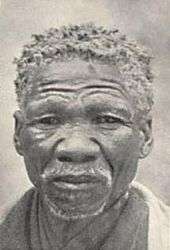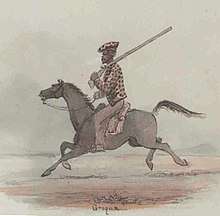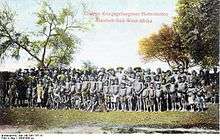Khoikhoi

The Khoikhoi (updated orthography Khoekhoe, from Khoekhoegowab Khoekhoen [kxʰoekxʰoen]; formerly also Hottentots[1]) are the traditionally nomadic pastoralist non-Bantu indigenous population of southwestern Africa. They are grouped with the hunter-gatherer San under the compound term Khoisan. The name Khoikhoi is the native self-designation, khoe-khoe, as it were "men of men, proper humans", from khoe "human being".[2]
While it is clear that the presence of the Khoikhoi in southern Africa predates the Bantu expansion, it is not certain by how much, possibly in the Late Stone Age, or displaced by the Bantu expansion to Southeastern Africa.[3] The Khoikhoi maintained large herds of Nguni cattle in the Cape region at the time of Dutch colonisation in the 17th century. Their nomadic pastoralism was mostly discontinued in the 19th to 20th century.[4]
Their Khoekhoe language is related to certain dialects spoken by foraging San peoples of the Kalahari, such as the Khwe and Tshwa, forming the Khoe language family. The two main Khoikhoi subdivisions today are the Nama people of Namibia, Botswana and South Africa (with numerous subtribes) and the Damara of Namibia. Their total number is estimated at close to 300,000 people.
The Griqua people are a mixed-raced population in South Africa, of partial Khoikhoi and partial European ancestry. They developed their own ethnic identity in the 19th century and settled in Griqualand.
History

Early history
The Khoikhoi, originally part of a pastoral culture and language group to be found across Southern Africa, originated in the northern area of modern Botswana. This ethnic group steadily migrated southward, eventually reaching the Cape approximately 2,000 years ago. Khoikhoi subgroups include the Namaqua to the west, the Korana of mid-South Africa, and the Khoikhoi in the south. Their husbandry of sheep, goats and cattle grazing in fertile valleys across the region provided a stable, balanced diet, and allowed the Khoikhoi to live in larger groups in a region previously occupied by the San, who were subsistence hunter-gatherers. Advancing Bantu in the 3rd century AD encroached on the Khoikhoi territory, pushing them into more arid areas. There was some intermarriage between migratory Khoi bands living around what is today Cape Town and the San. But the two groups remained culturally distinct, as the Khoikhoi continued to graze livestock and the San to subsist on hunting-gathering.
Arrival of Europeans
The Khoi first encountered Portuguese explorers and merchants around AD 1500. The ongoing encounters were often violent. Local population dropped after the Khoi were exposed to smallpox by Europeans, who carried it as an endemic disease. The Khoi suffered high mortality as they had no acquired immunity to the new infectious disease. The Khoi waged more frequent attacks against Europeans when the Dutch East India Company enclosed traditional grazing land for farms. Over the following century, the Khoi were steadily driven off their land, which effectively ended their traditional life.
Khoikhoi social organisation was profoundly damaged and, in the end, destroyed by colonial expansion and land seizure from the late 17th century onwards. As social structures broke down, some Khoikhoi people settled on farms and became bondsmen (bondservants) or farm workers; others were incorporated into existing clan and family groups of the Xhosa people. Georg Schmidt, a Moravian Brother from Herrnhut, Saxony, now Germany, founded Genadendal in 1738, which was the first mission station in southern Africa,[5] among the Khoi people in Baviaanskloof in the Riviersonderend Mountains.

Griqua
Early European settlers sometimes intermarried with indigenous Khoikhoi women, resulting in a sizeable mixed-race population now known as the Griqua. They were known at the time as "Basters" and in some instances are still so called, e. g., the Bosluis Basters of the Richtersveld and the Baster community of Rehoboth, Namibia.
Another group were the Griqua. Like other mixed-race peoples and the Khoikhoi, they left the Cape Colony and migrated into the interior. Responding to the influence of missionaries, they formed the states of Griqualand West and Griqualand East; these were later absorbed into the Cape Colony of the British Empire.
Kat River settlement (1829–1856) and the Khoi in the Cape Colony

By the early 1800s, the remaining Khoi of the Cape Colony suffered from restricted civil rights and discriminatory laws on land ownership. With this pretext, the powerful Commissioner General of the Eastern Districts, Andries Stockenstrom, facilitated the creation of the "Kat River" Khoi settlement near the eastern frontier of the Cape Colony. The more cynical motive was probably to create a buffer-zone on the Cape's frontier, but the extensive fertile land in the region allowed the Khoi to own their land and build communities in peace. The settlements thrived and expanded, and Kat River quickly became a large and successful region of the Cape that subsisted more or less autonomously. The people were predominantly Afrikaans-speaking Gonaqua Khoi, but the settlement also began to attract other Khoi, Xhosa and mixed-race groups of the Cape.
The Khoi were known at the time for being very good marksmen, and were often invaluable allies of the Cape Colony in its frontier wars with the neighbouring Xhosa. In the Seventh Frontier War (1846–1847) against the Gcaleka Xhosa, the Khoi gunmen from Kat River distinguished themselves under their leader Andries Botha in the assault on the "Amatola fastnesses". (The young John Molteno, later Prime Minister, led a mixed Commando in the assault, and later praised the Khoi as having more bravery and initiative than most of his white soldiers.)[6]
However harsh laws were still implemented in the Eastern Cape, to encourage the Khoi to leave their lands in the Kat River region and to work as labourers on white farms. The growing resentment exploded in 1850. When the Xhosa rose against the Cape Government, large numbers of Khoi joined the Xhosa rebels for the first time.[7] After the defeat of the rebellion and the granting of representative government to the Cape Colony in 1853, the new Cape Government endeavoured to grant the Khoi political rights to avert future racial discontent. Attorney General William Porter was famously quoted as saying that he "would rather meet the Hottentot at the hustings, voting for his representative, than meet him in the wilds with his gun upon his shoulder".[8] Thus, the government enacted the Cape franchise in 1853, which decreed that all male citizens meeting a low property test, regardless of colour, had the right to vote and to seek election in Parliament. However, this non-racial principle was eroded in the late 1880s by a literacy test, and later abolished by the Apartheid Government.[9]

Massacres in German South-West Africa
From 1904 to 1907, the Germans took up arms against the Khoikhoi group living in what was then German South-West Africa, along with the Herero. Over 10,000 Nama, more than half of the total Nama population at the time, may have died in the conflict. This was the single greatest massacre ever witnessed by the Khoikhoi people.[10][11]
Culture
Religion
The religious mythology of the Khoikhoi gives special significance to the Moon, which may have been viewed as the physical manifestation of a supreme being associated with heaven. Tsui'goab is also believed to be the creator and the guardian of health, while Gunab is primarily an evil being, who causes sickness or death.[12] Many Khoikhoi have converted to Christianity and Nama Muslims make up a large percentage of the Namibia's Muslims.[13]
World Heritage
UNESCO has recognised Khoikhoi culture through its inscription of the Richtersveld as a World Heritage Site. This important area is the only place where transhumance practices associated with the culture continue to any great extent.
The International Astronomical Union named the primary component of the binary star Mu¹ Scorpii after the traditional Khoikhoi name Xami di mura ('eyes of the lion').[14]
See also
References
- ↑ "Hottentot, n. and adj." OED Online, Oxford University Press, March 2018, www.oed.com/view/Entry/88829. Accessed 13 May 2018. Citing G. S. Nienaber, 'The origin of the name “Hottentot” ', African Studies, 22:2 (1963), 65-90, doi:10.1080/00020186308707174. See also Rev. Prof Johannes Du Plessis, B.A., B.D. (1917). "Report of the South African Association for the Advancement of Science". pp. 189–193. Retrieved 5 July 2010. . Strobel, Christoph (2008). "A Note on Terminology". The Testing Grounds of Modern Empire: The Making of Colonial Racial Order in the American Ohio Country and the South African Eastern Cape, 1770s–1850s. Peter Lang. Desmond, Adrian; Moore, James (2014). "Living in Slave Countries". Darwin's Sacred Cause: How a Hatred of Slavery Shaped Darwin's Views on Human Evolution. Houghton Mifflin Harcourt. p. 103. Jeremy I. Levitt, ed. (2015). "Female "things" in international law". Black Women and International Law. Cambridge University Press. p. 291. "Bring Back the 'Hottentot Venus'". Web.mit.edu. 15 June 1995. Retrieved 13 August 2012. "Hottentot". American Heritage Dictionary of the English Language (Fifth ed.). Boston: Houghton Mifflin. 2011. "'Hottentot Venus' goes home". BBC News. 29 April 2002. Retrieved 13 August 2017.
- ↑ "The old Dutch also did not know that their so-called Hottentots formed only one branch of a wide-spread race, of which the other branch divided into ever so many tribes, differing from each other totally in language [...] While the so-called Hottentots called themselves Khoikhoi (men of men, i.e. men par excellence), they called those other tribes Sā, the Sonqua of the Cape Records [...] We should apply the term Hottentot to the whole race, and call the two families, each by the native name, that is the one, the Khoikhoi, the so-called Hottentot proper; the other the Sān (Sā) or Bushmen." Theophilus Hahn, Tsuni-||Goam: The Supreme Being to the Khoi-Khoi (1881), p. 3.
- ↑ Barnard, Alan (1992) Hunters and Herders of Southern Africa: A Comparative Ethnography of the Khoisan Peoples. New York; Cambridge: Cambridge University Press, 1992.
- ↑
Richards, John F. (2003). "8: Wildlife and Livestock in South Africa". The Unending Frontier: An Environmental History of the Early Modern World. California World History Library. 1. Berkeley, California: University of California Press. p. 296. ISBN 9780520939356. Retrieved 17 November 2016.
The nomadic pastoral Khoikhoi kraals were dispersed and their organization and culture broken. However, their successors, the trekboers and their Khoikhoi servants, managed flocks and herds similar to those of the Khoikhois. The trekboers had adapted to African-style, extensive pastoralism in this region. In order to obtain optimal pasture for their animals, early settlers imitated the Khoikhoi seasonal transhumance movements and those observed in the larger wild herbivores.
- ↑ The Pear Tree Blossoms, Bernhard Krueger, Hamburg, Germany
- ↑ Molteno, P. A. (1900). The life and times of Sir John Charles Molteno, K. C. M. G., First Premier of Cape Colony, Comprising a History of Representative Institutions and Responsible Government at the Cape. London: Smith, Elder & Co.
- ↑ Osterhammel, Jürgen (2015). The Transformation of the World: A Global History of the Nineteenth Century. Translated by Patrick Camiller. Princeton, New Jersey; Oxford: Princeton University Press. p. 251. ISBN 9780691169804.
- ↑ Vail, Leroy, ed. (1989). The Creation of Tribalism in Southern Africa. Berkeley: University of California Press. ISBN 0520074203. Retrieved 7 April 2015.
- ↑ Fraser, Ashleigh (3 June 2013). "A Long Walk To Universal Franchise in South Africa". HSF.org.za. Retrieved 7 April 2015.
- ↑ Jeremy Sarkin-Hughes (2008) Colonial Genocide and Reparations Claims in the 21st Century: The Socio-Legal Context of Claims under International Law by the Herero against Germany for Genocide in Namibia, 1904–1908, p. 142, Praeger Security International, Westport, Conn. ISBN 978-0-313-36256-9
- ↑ Moses, A. Dirk (2008). Empire, Colony, Genocide: Conquest, Occupation and Subaltern Resistance in World History. New York: Berghahn Books. ISBN 9781845454524.
- ↑ "Reconstructing the Past – the Khoikhoi: Religion and Nature".
- ↑ "Islam in Namibia, making an impact". Islamonline.net.
- ↑ "IAU Approves 86 New Star Names From Around the World" (Press release). IAU.org. 11 December 2017.
Further reading
- P. Kolben, Present State of the Cape of Good Hope (London, 1731–38);
- A. Sparman, Voyage to the Cape of Good Hope (Perth, 1786);
- Sir John Barrow, Travels into the Interior of South Africa (London, 1801);
- Bleek, Wilhelm, Reynard the Fox in South Africa; or Hottentot Fables and Tales (London, 1864);
- Emil Holub, Seven Years in South Africa (English translation, Boston, 1881);
- G. W. Stow, Native Races of South Africa (New York, 1905);
- A. R. Colquhoun, Africander Land (New York, 1906);
- L. Schultze, Aus Namaland und Kalahari (Jena, 1907);
- Meinhof, Carl, Die Sprachen der Hamiten (Hamburg, 1912);
- Richard Elphick, Khoikhoi and the Founding of White South Africa (London, 1977)
External links
| Wikimedia Commons has media related to Khoikhoi. |
| Wikisource has the text of the 1911 Encyclopædia Britannica article Hottentots. |